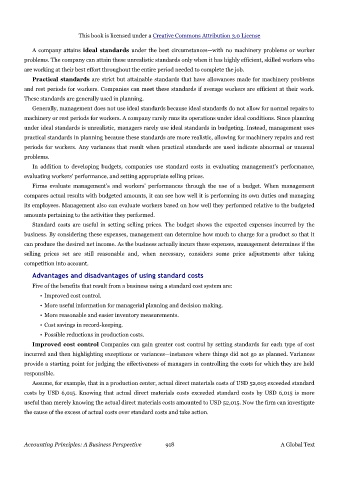Page 917 - Accounting Principles (A Business Perspective)
P. 917
This book is licensed under a Creative Commons Attribution 3.0 License
A company attains ideal standards under the best circumstances—with no machinery problems or worker
problems. The company can attain these unrealistic standards only when it has highly efficient, skilled workers who
are working at their best effort throughout the entire period needed to complete the job.
Practical standards are strict but attainable standards that have allowances made for machinery problems
and rest periods for workers. Companies can meet these standards if average workers are efficient at their work.
These standards are generally used in planning.
Generally, management does not use ideal standards because ideal standards do not allow for normal repairs to
machinery or rest periods for workers. A company rarely runs its operations under ideal conditions. Since planning
under ideal standards is unrealistic, managers rarely use ideal standards in budgeting. Instead, management uses
practical standards in planning because these standards are more realistic, allowing for machinery repairs and rest
periods for workers. Any variances that result when practical standards are used indicate abnormal or unusual
problems.
In addition to developing budgets, companies use standard costs in evaluating management's performance,
evaluating workers' performance, and setting appropriate selling prices.
Firms evaluate management's and workers' performances through the use of a budget. When management
compares actual results with budgeted amounts, it can see how well it is performing its own duties and managing
its employees. Management also can evaluate workers based on how well they performed relative to the budgeted
amounts pertaining to the activities they performed.
Standard costs are useful in setting selling prices. The budget shows the expected expenses incurred by the
business. By considering these expenses, management can determine how much to charge for a product so that it
can produce the desired net income. As the business actually incurs these expenses, management determines if the
selling prices set are still reasonable and, when necessary, considers some price adjustments after taking
competition into account.
Advantages and disadvantages of using standard costs
Five of the benefits that result from a business using a standard cost system are:
• Improved cost control.
• More useful information for managerial planning and decision making.
• More reasonable and easier inventory measurements.
• Cost savings in record-keeping.
• Possible reductions in production costs.
Improved cost control Companies can gain greater cost control by setting standards for each type of cost
incurred and then highlighting exceptions or variances—instances where things did not go as planned. Variances
provide a starting point for judging the effectiveness of managers in controlling the costs for which they are held
responsible.
Assume, for example, that in a production center, actual direct materials costs of USD 52,015 exceeded standard
costs by USD 6,015. Knowing that actual direct materials costs exceeded standard costs by USD 6,015 is more
useful than merely knowing the actual direct materials costs amounted to USD 52,015. Now the firm can investigate
the cause of the excess of actual costs over standard costs and take action.
Accounting Principles: A Business Perspective 918 A Global Text

